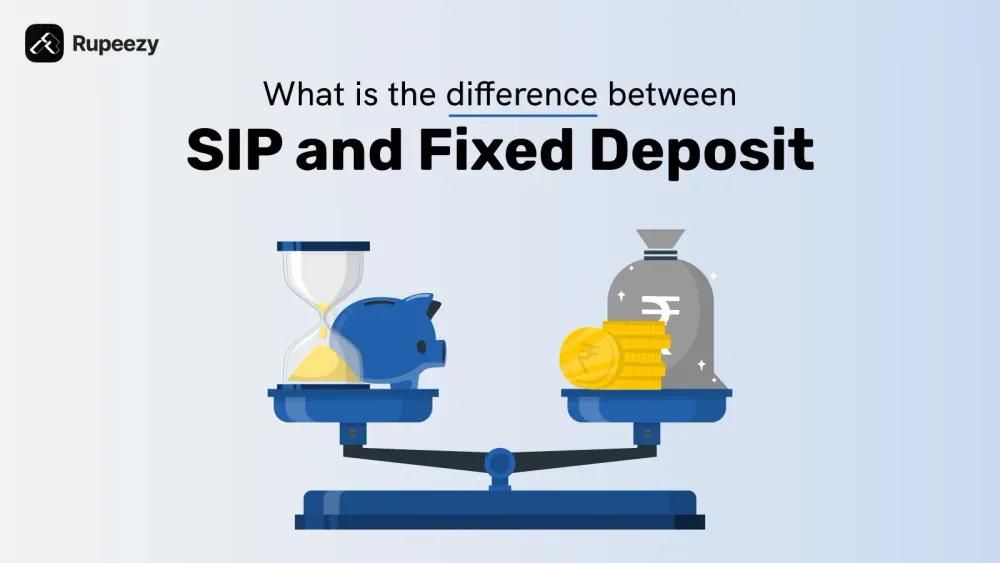SIP vs FD: Which is a Better Investment Option for You?


00:00 / 00:00
Investing effectively is a way to make your money work on your behalf to build your wealth for the future. While parking your cash in a savings account is always considered a safer strategy, only investing your money allows it to grow its value over time with the magic of compounding and long-term growth. There are various investment avenues like equity stocks, bonds, mutual fund sips, futures and options, metal stocks, real estate, bank fixed deposits, commodities, etc, where one can look to grow their wealth.
In this blog, we will help you understand two of the well-known investment avenues, that is, SIP and FD meaning. Furthermore, we will compare the systematic investment plan vs fixed deposit (SIP vs FD) with the help of examples.
What is a SIP?
A Systematic Investment plan is a process for disciplined investments in mutual funds. This method helps an investor to invest a fixed amount of money at fixed intervals in the selected mutual fund schemes. This helps the investors increase the size of their portfolio over time rather than having to invest the entire amount at once.
It is an investment vehicle designed for mutual fund investors to have periodical investments in smaller amounts. A detailed article on Rupeezy’s Blog site can help you better understand how to invest in SIP and the best SIP for long term.
Features of SIP:
1. SIP allows investors to consistently invest a small portion of their funds into a mutual fund.
2. SIPs can be formed for a wide range of products like equity mutual funds, Hybrid Funds, ETFs, Debt Funds, etc.
3. It fosters diversification of one’s portfolio by investing in small portions of multiple sectors collectively.
4. SIPs provide investors an option to invest a small portion of funds periodically thereby reducing the burden of investing lump-sum amounts.
5. Investing through SIPs offers higher returns potential in the long term with the benefit of compounding interest.
6. As per the Income Tax Act 1961, Section 80C, investing in an Equity-linked savings scheme (ELSS) is allowed Tax deductions of up to Rs.1,50,000.
7. SIPs are subject to capital gains tax at the time of redemption of the mutual fund. If the duration of investment is less than 12 months it falls under short-term capital gains at 15% tax, and if the investment exceeds 1 year it will be termed as long-term capital gains and will be taxed at 15% for that financial year.
Pros and Cons of Systematic Investment Plans (SIP):
Pros | Cons
|
Affordability: It allows the investors to invest their funds at a very minimal rate, starting from Rs.100. | Market Risk: The value of the investment can fluctuate up and down based on the market conditions. So there is no guarantee about the returns on the investment. |
Rupee Cost Averaging: This is taking advantage of the market volatility. By investing a fixed amount at regular intervals, the investor gets more units if the market is down or vice versa. | Fluctuating Market Returns: SIPs are subject to market volatility, as the market moves high and low even the returns will change continuously. |
Diversification: SIP investments, facilitate the investors to spread their investments in a wide range of assets thereby minimizing their risks. | Dependence of Fund Manager: Through SIPs, the investor is overly dependent on the fund manager to manage their investment. If the fund manager’s performance declines it can have an overall impact on the returns of your investments. |
What is an FD?
Fixed Deposits (FD) are popular investment choices that have prevailed for a long time in the market. The banks mainly design it for conservative investors seeking stable returns with minimal investment risks. It is an avenue where you park a fixed lump-sum amount in the bank for a fixed term at pre-fixed interest rates, which can fetch guaranteed returns regardless of market volatility. Different banks offer varying returns based on the amount invested, tenure of the investment, etc. FDs are considered safe investment plans as they fetch assured returns and capital protection making them a good option for risk-averse investors.
Features of FD:
1. FD provides assured returns in the form of fixed interest rates, which makes the investors risk-averse.
2. The tenure of FDs is flexible, which can range from 7 days to 10 years.
3. FDs can be used as collateral for taking a loan. Most banks offer the FD holders to take a loan against their deposit ranging from 70% - 90% of their capital. The Loan interest rate will usually be 1% or 2% higher than the FD returns, depending on the bank’s policy.
4. According to the Interest payout terms, the FDs can be categorized as cumulative and non-cumulative FDs. The difference is that in a Cumulative FD, the investor receives the interest amount along with the principal at the end of the maturity. On the other hand in a Non Cumulative FD, the investor receives the interest periodically on a monthly, quarterly, half-yearly, or annual basis.
5. As per the Income Tax Act 1961, Section 80C, FDs are allowed Tax deductions of up to Rs.1,50,000.
6. The interest received on FDs is taxable based on the investor's income tax slab. Also, the TDS (Tax Deducted at Source) applies to the interest income on FDs.
7. A subsidiary under the governance of RBI - DICGC (Deposit Insurance and Credit Guarantee Corporation) provides the FD investors insurance of up to Rs. 5,00,000 to safeguard their investments if the bank fails to pay the deposit holder.
Pros and Cons of Fixed Deposits (FDs):
Pros | Cons
|
Stable Returns: FDs provide fixed returns which are pre-determined by the respective banks at the time of depositing the amount. This benefit attracts the risk-averse investors. | Lower returns: Comparing other investment avenues, FDs provide lower returns, which can lead to eroding the value of the investment by the end of the investment tenure. |
Lower risk of funds: FDs are considered the safest investment because they are insured by the government or other financial institutions. If in case the bank fails to pay back the deposit, the insurer will pay the amount of up to Rs. 500,000. | Inflation Risk: Inflation is the rise in prices over time. If the FD interest rate is lower than the inflation rate, there will be a loss of purchasing power each year. |
Tax Benefits: FDs are allowed for tax deductions of up to Rs. 1,50,000 as per Section 80C of the Income Tax Act 1961 | Penalty on Premature Withdrawals: The FD investors are not generally allowed to withdraw their deposits before maturity. If in case they withdraw, a penalty fee is charged on the investment. The fee may vary depending on the bank. |
FD vs SIP - Understand with Examples
Imagine Ravi has Rs.1,00,000 that he wants to invest safely. He goes to his bank and opts for a Fixed Deposit, which offers a 6% annual interest rate for a period of 5 years. Ravi deposits his money and knows that after 5 years; he will receive a fixed amount of Rs.1,30,000. This includes his original Rs.1,00,000 plus Rs.30,000 in interest. Ravi likes the FD because it’s low risk, and he knows exactly how much he will get back.
On the other hand, Priya is willing to take some risk for the possibility of higher returns and likes the flexibility of investing smaller amounts regularly. So, Priya decided to invest Rs.2,500 every month for 5 years in a mutual fund through SIP. She chooses an equity mutual fund that historically averages around 12% annual returns. Unlike Ravi's FD, Priya's returns aren’t guaranteed and can fluctuate with market performance. However, after 5 years, Priya has invested Rs.1,50,000 and it has grown to approximately Rs.2,06,216, thanks to the power of compounding and the higher potential returns of the equity market.
In summary, Ravi's FD offers a safe and predictable return, while Priya's SIP has the potential for higher returns with more risk.
Key Differences Between SIP and FD
Parameter | Fixed Deposits (FD) | Systematic Investment Plan (SIP) |
1. Risk Profile | Comparatively very low risk as they are not correlated or affected by the market fluctuations. | It has medium to high risks, as these investments are subject to market volatility and fluctuations. |
2. Investment Amount | It has to be made as a one-time lump-sum investment and is parked there for a fixed tenure. | Investments can be made in the form of installments as weekly, monthly, quarterly, or even annually. |
3. Investment Objective | The objective is for capital preservation with assured fixed returns | The aim is to grow the investor’s capital by investing strategically for higher returns along with moderate risks. |
4. Investment Duration | They have predetermined terms on the duration of the investment which can range from seven days to 10 years. This must be followed until the maturity of the contract. | SIPs are flexible in duration which allows the investors to invest and withdraw their capital based on the performance without any duration constraints. |
5. Liquidity | FDs can be withdrawn before the maturity of the contract by paying fees as a penalty. | SIPs provide high liquidity as the invested amount can be withdrawn anytime; however, the investor may have to pay the exit load fees at the time of withdrawal. (transactions made during the holidays will be processed during the next trading day) |
6. Investment Returns | FDs provide fixed returns on the deposits, though it is a little lower than other investment avenues, the banks offer assured returns on their deposits. | SIPs don’t offer any guaranteed returns on the investment made in the mutual funds as there are many risks associated with the investments. |
7. Type of Returns | They provide returns in the form of Interest on the deposit. | SIPs generate returns through Capital appreciation and Dividends. |
8. Tax Applied | The interest earned on FDs per fiscal year is added to the income and taxed according to the tax slab. | Capital gains on mutual funds are taxed based on the holding period and the type of mutual fund. |
Check out our latest articles to learn more about SIP vs RD and the Difference Between SIP And Mutual Fund
SIP vs FD: Which One is Better?
With the help of the above differentiation on SIP vs FD, you will be able to understand which method suits your objective. You can consider investing in both FDs and SIPs to establish a consistent long-term investment strategy.
FDs are a reliable choice for those who prefer low-risk investments with guaranteed returns. Conversely, SIPs in mutual funds come with higher risks but also offer greater return potential over the long run. Regular and disciplined investing through SIPs can help you build a substantial amount of wealth.
Conclusion
So wrapping up all the above points, we can identify the meaning and benefits associated with both the investment option and also the key differences between FD and SIP. It is important to keep your investments diversified to minimize the risk of losing all your wealth because of a single factor. So, before investing in any avenue do your research and analysis, and based on your risk appetite and investment objective make the right investment decision.
Together, these investment options can significantly boost your wealth-building efforts, helping you achieve your financial goals more efficiently. Even if you have yet to begin your investment journey, familiarizing yourself with these various investment options will be beneficial.
For personalized financial solutions and to make the most of these investment opportunities, explore Rupeezy's offerings. Start your journey with the Rupeezy App today and make informed investment decisions.
The content on this blog is for educational purposes only and should not be considered investment advice. While we strive for accuracy, some information may contain errors or delays in updates.
Mentions of stocks or investment products are solely for informational purposes and do not constitute recommendations. Investors should conduct their own research before making any decisions.
Investing in financial markets are subject to market risks, and past performance does not guarantee future results. It is advisable to consult a qualified financial professional, review official documents, and verify information independently before making investment decisions.

All Category









